Content
Published:
This is an archived release.
Health behaviour – women in the lead?
Has the focus on a healthier lifestyle and better health in recent years made any difference? National figures on health behaviour show that daily smoking has decreased, and that more people are physically active. As far as alcohol consumption and being overweight are concerned, the picture is unchanged. So far, there seems to be no reduction in the number of people with cardiovascular diseases.
| Basic school level | Secondary level | Tertiary level (university) | ||||
|---|---|---|---|---|---|---|
| 2012 | Change from 2002 (percentage points) | 2012 | Change from 2002 (percentage points) | 2012 | Change from 2002 (percentage points) | |
| Drink alcohol 2 or more times per week | 18 | 2 | 24 | 2 | 38 | 2 |
| Daily smoking | 35 | -9 | 23 | -12 | 11 | -9 |
| Physically inactive | 18 | -14 | 9 | -15 | 6 | -13 |
| Exercise regularly (weekly) | 72 | 17 | 80 | 12 | 87 | 16 |
| Overweight/obese | 34 | 6 | 34 | 3 | 29 | 5 |
| Cardio-vascular diseases | 25 | -1 | 23 | -1 | 18 | -1 |
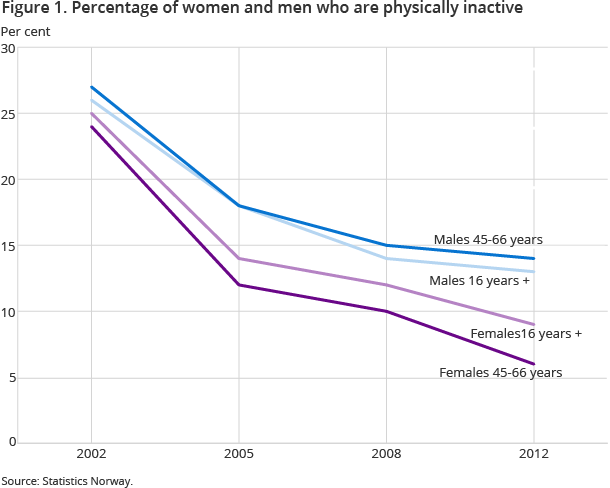
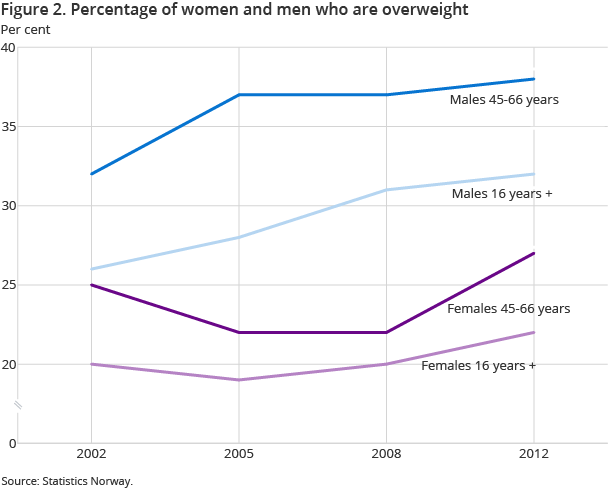
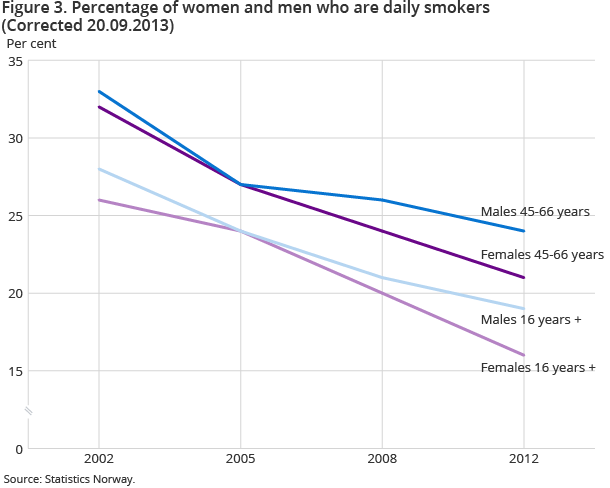
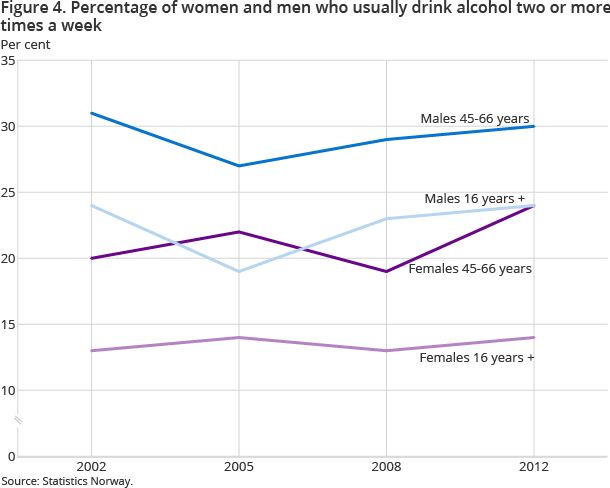
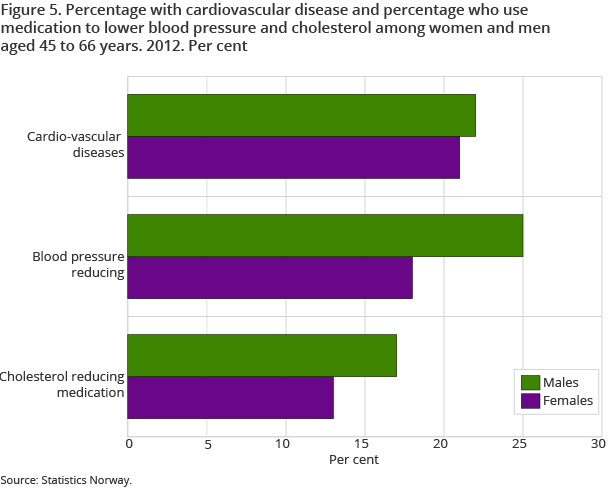
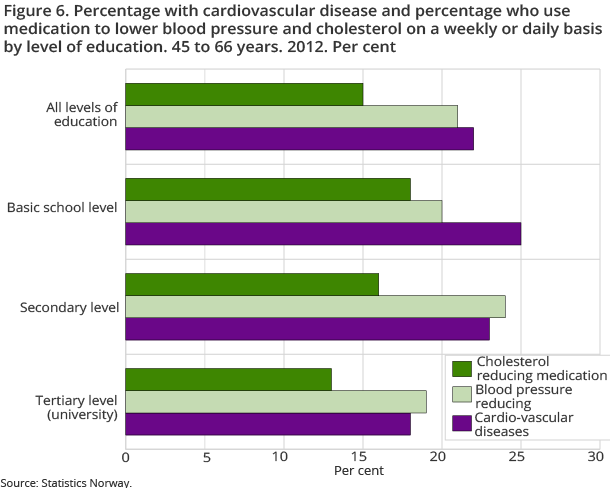
The 2012 health interview survey shows that 17 per cent of the Norwegian population smokes daily and 19 per cent drinks alcohol more frequently than 2 days a week. A large majority claim to be physically active, while 11 per cent are inactive. Twenty-seven per cent of Norwegians are overweight (BMI>27). Ten per cent of these are obese. Physical activity and being overweight has shown a more positive trend among women than men.
600 000 living with cardiovascular diseases
Seventeen per cent of the adult population, or approximately 600 000, are living with health problems related to cardiovascular diseases with varying degrees of seriousness. About as many women as men are living with such diseases. Development of cardiovascular diseases is related to smoking habits, being overweight and inactivity. It is particularly after the age of 40 that many are affected. Twenty-two per cent in the age group 45 to 66 years stated that they had some form of cardiovascular disease in 2012. There has been no notable change in the prevalence of cardiovascular disease among the 45-66-year olds during the last ten years. The percentage has varied from 19 to 22 per cent, with no apparent trend.
Middle aged persons exercise a lot, but also smoke and drink more…
The middle aged, between 45 and 66 years, are above the population average with regard to smoking, being overweight and alcohol consumption. The level of daily smokers is about 5 percentage points higher among the middle aged than in the average population. As for the population in general, the percentage with moderate alcohol consumption is almost unchanged over the last 10 years.
An increasing number in the 45-66 age group state that they exercise regularly. Only 10 per cent are inactive. The increased physical activity has apparently not influenced the figures for being overweight and obesity. Almost four out of ten men in the age group 45-66 years are overweight or obese (BMI>27). The same is true for three in ten in the male population. Even among women, being overweight is more common in the age group 45-66 years than in the female population in general. In this age group, being overweight, inactivity and smoking are more widespread in groups with a low level of education compared to groups with higher education. The exception is alcohol consumption, where the correlation is reversed.
Table 1 shows the change in percentage points from 2002 to 2012 in living habits by level of education. There has been a decrease in inactivity and daily smoking in all education groups. Alcohol consumption and being overweight/obesity have increased. Cardiovascular diseases occur less frequently among middle aged persons with a university education than those with a lower education. In 2012, the percentages were 18 per cent among those with a university education, 23 per cent among those with an upper secondary education and 25 per cent among those with a lower secondary education. The differences between the education groups have neither increased nor decreased over the last 10 years.
… and many use medication to reduce blood pressure and cholesterol
Women and men in the age group 45-66 years state that they have cardiovascular diseases to about the same extent. Nevertheless, fewer women than men used medication to reduce blood pressure or cholesterol in 2012.
There appears to be a correlation between the occurrence of cardiovascular disease and the use of medication to reduce blood pressure and cholesterol among 45-66 year-olds within each education group. The exception is that use of medication to lower blood pressure is less common among people with a lower secondary education, even if they have the highest incidence of cardiovascular diseases. In the two groups with the highest education, it appears that the use of medication to reduce high blood pressure is higher than the occurrence of cardiovascular diseases should call for.
Sample and response rateOpen and readClose
Data from the health interview survey is representative for the population living in private households. A sample of 5 660 persons 16 years and older was interviewed by telephone. The response rate in 2012 was 58 per cent.
Find more figures
Find detailed figures for Health, care and social relations, survey on living conditions
Contact
-
Elin Skretting Lunde
E-mail: elin.skretting.lunde@ssb.no
tel.: (+47) 92 42 70 07
-
Jorun Ramm
E-mail: jorun.ramm@ssb.no
tel.: (+47) 92 08 23 99
-
Berit Otnes
E-mail: berit.otnes@ssb.no
tel.: (+47) 45 00 49 34
